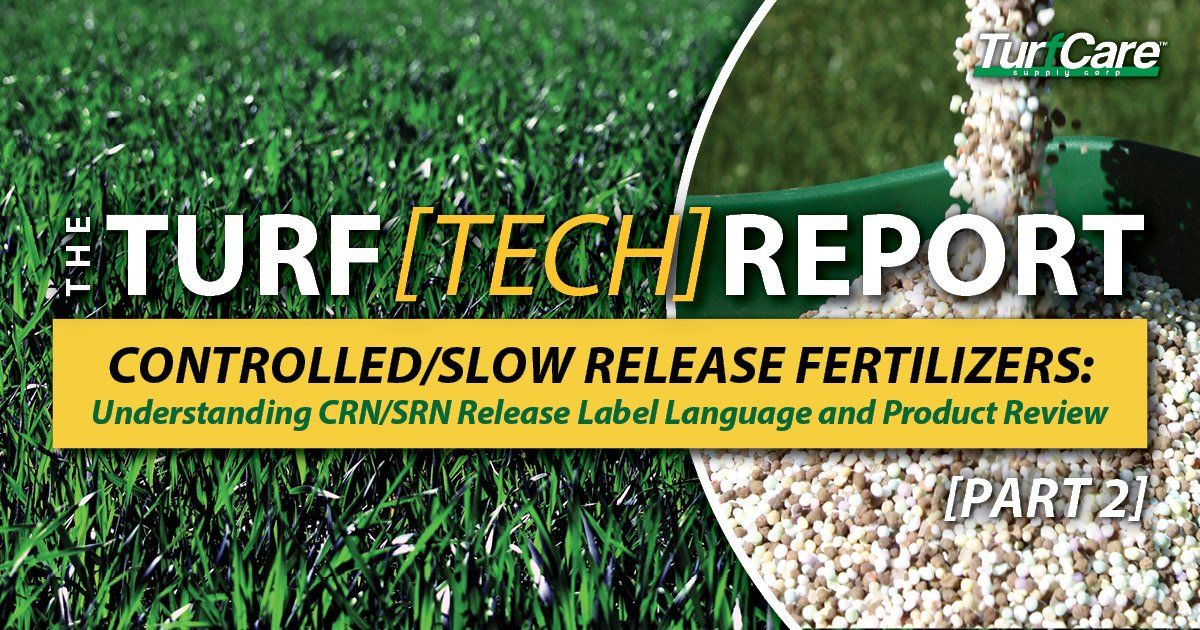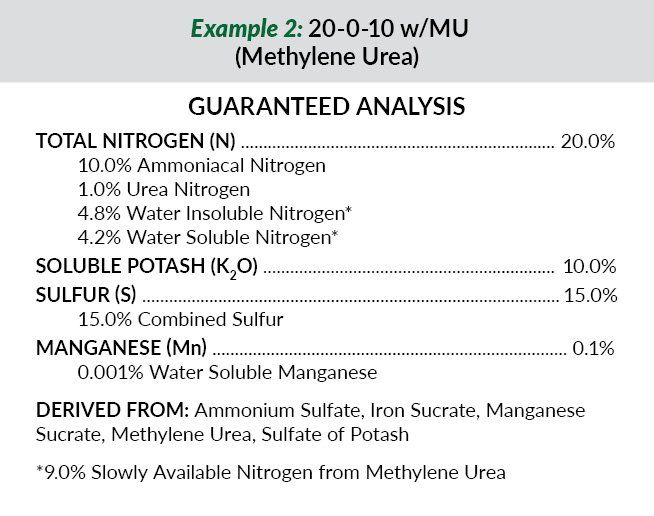UNDERSTANDING CRN/SRN RELEASE LABEL LANGUAGE AND PRODUCT REVIEW
This segment of Turf[TECH]Report, is the second of a two-part series. Part 1
focused on how controlled/slow release fertilizers work, and how to compare the various technologies. This series, Part 2 takes the time to teach you how to read and understand controlled/slow release label language and review the different kinds of products on the market. This article will supply you with all the important information you need to determine which slow/controlled release fertilizer is best for you.
HOW TO READ AND UNDERSTAND A SLOW RELEASE NITROGEN FERTILIZER LABEL
Every label containing SRN will show the total amount of nitrogen, the form(s) and percentage(s) of nitrogen, the raw ingredient(s) nitrogen is derived from, and the percent of slow release nitrogen in the bag (as well as the source of the SRN). Let’s break down what these numbers mean.
This fertilizer mix contains 8% nitrogen in the bag and contains Polymer Coated Sulfur Coated Urea. 7.2% of the total bag is urea nitrogen. This means that 90% of all the nitrogen in the bag is slow release urea nitrogen (7.2%/8.0% = 90%). This does NOT mean that 90% of the bag is slow release nitrogen, only that 90%
of the total nitrogen is slow release. The remaining nitrogen (.8% of the total bag by content) is ammoniacal nitrogen. Understand that the asterisk at the bottom says *7.2% slowly available nitrogen from polymer coated urea. Because this 7.2% value is the same as the 7.2% urea nitrogen value at the top, we can infer that 100% of all the urea in this fertilizer is in the form of slow release. In other words, there is no “straight urea” floating around in this mix. 100% of the urea is coated. Remember, all percentage values on labels are always based on the total amount of that specific ingredient in the entire bag, NOT the percentage of an ingredient within an elemental subsection.
This fertilizer mix contains 20% total nitrogen in the bag. 10% of the entire bag is ammoniacal nitrogen. Only 1% of the bag is straight urea nitrogen. 4.8% of the bag is water insoluble nitrogen (WIN) (from MU). This means that 4.8% of the nitrogen is not readily accessible and cannot be used by plants until is converted into a usable form (such as straight urea). It takes time for WIN to become accessible (hence WIN is a form of slow-release). Also note that 4.2% of the bag is water soluble nitrogen (WSN) (also from MU). This means that while this nitrogen is still not ready for use by plants, 4.2% of nitrogen is readily dissolvable in water and is ready to be acted on by the environment (in this case, microbes) for conversion into straight urea, which can then be converted once more into usable nitrogen for plants. In the case of this example, the WIN and WSN add up to 9%. The statement at the bottom indicates that 9% of the entire content of the bag is slow release nitrogen (sometime called “slowly available nitrogen”) and is derived from methylene urea. (Remember, the release of MU nitrogen is based on the activity of soil microbes). If the total amount of nitrogen in the bag is 20%, and 9% is slow release nitrogen, then 11% must be the total amount of immediate release nitrogen in the bag.
BRINGING IT ALL TOGETHER – REVIEWING THE BENEFITS OF SRNS
The math and science behind how the guaranteed analysis of an SRN label is calculated can become confusing, especially when terms such as “controlled release,” “slow release,” “water soluble nitrogen,” and “water insoluble nitrogen” are often used interchangeably and/or misapplied. Regardless of what something is called, all that matters is understanding the mode-of-action behind the type of slow release nitrogen inside your bag of fertilizer. It is also important to remember that some fertilizers contain 100% SRN, while others contain a mix of both slow and immediate release nitrogen. If you are unsure as to exactly what you are purchasing, always ask the manufacturer or retailer questions so that you don’t end up purchasing the wrong product for your situation.
SUMMARY OF SLOW RELEASE NITROGEN SPECS AND BENEFITS:
- SRN comes in two forms: “coated” and “reacted”
- Coated: encapsulated urea granule; coated with sulfur, polymer, wax, or any combination thereof
- Reacted: chemically or biologically converted by microbes; this slow release is highly influenced by temperature and moisture
- Each SRN has a different release profile based on the chemistry and physical science of the fertilizer granule
- Release curves report the nitrogen release profile of a SRN and can be used to compare different products
- SRNs help deter leaching and volatilization
- SRNs are safer for plants; they shift the pH of the ground significantly less than IRNs (burning plants is virtually impossible, even if accidentally over applying fertilizer)
- SRNs help reduce the number of fertilizer applications in a growing season resulting in significant labor and energy cost savings.
- SRNs are biodegradable and environmentally friendly
WHAT SLOW/CONTROLLED RELEASE NITROGEN PRODUCTS DOES TURF CARE OFFER?
TurfCare™ Supply offers a wide variety of premium SRNs with a well-established reputation for quality and reliability in the turf and ornamental industry. All of our products are available in standard size granules, with some offerings in mini (smaller) and elite (smallest) sizes.
Featured Products:
- SCU
- PCU (featuring Duration CR® with 45, 90, 120, and 180-day release times)
- PSCSU (featuring XCU®)
- MU (featuring Nutraline®)
For professional fertilizers, humic and AMP-XC™ enriched products available, please visit TurfCare’s online Product Catalog.
For green industry professionals or others interested in ordering Turfcare products, please contact our Customer Service
to find a distributor near you.
References:
https://www.cdfa.ca.gov/is/ffldrs/pdfs/Ellison_Eric.pdf
http://www.kochturf.com/products/slowrelease/nutralene/
https://extension.udel.edu/weeklycropupdate/?p=9131
http://ipm.ucanr.edu/TOOLS/TURF/MAINTAIN/winamt.html
Publication: Controlled Release Fertilizers – AgIndustries Research & Consulting
Turf Care Supply - TurfReport Blog
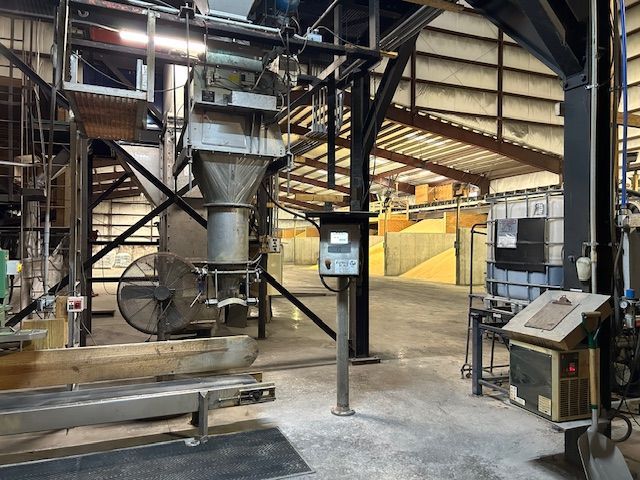
Turf Care Supply, LLC, a portfolio company of Platte River Equity, has officially acquired Beaty Fertilizer, the industry respected Tennessee-based manufacturer and blender of custom granular and liquid fertilizers, as well as combination products. This strategic move expands Turf Care’s manufacturing footprint, adds new product capabilities, and enhances overall production capacity. “The partnership with Beaty Fertilizer marks a major milestone in our journey and an important step forward in our mission to grow, innovate and lead in our industry,” said Mark Mangan, President of Turf Care. “This acquisition is more than just expansion; it’s a powerful opportunity to strengthen our product offerings, broaden our market reach and provide greater value to our customers. By welcoming Beaty into the Turf Care family, we are reinforcing our commitment to excellence and positioning ourselves for an even brighter future.” “We are excited about this next step in the Beaty Fertilizer story. For almost 50 years, our family and our employees have worked hard to serve customers and communities with pride and heart,” said John Beaty, President of Beaty. “Now, we are embracing an opportunity for growth with Turf Care. With our combined know-how and resources, we’ll keep building on what we’ve worked so hard to create and bring even more value to our customers, employees and partners. We truly believe this partnership will keep the Beaty legacy going strong while opening up new doors for growth and innovation.” Tarun Kanthety, Vice President at Platte River, added, “We believe the acquisition of Beaty Fertilizer represents a strategic step in expanding Turf Care’s footprint and product breadth... as it scales and enhances its value proposition to customers.”
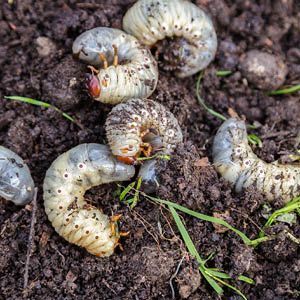
Root out Grubs, Before they Attack Yours! White grubs, the immature stage of several scarab beetles—including Japanese beetles, masked chafers, May and June beetles, and green June beetles—are a major threat to turfgrass across the Southeast. These beetles follow a complete metamorphosis (egg, grub, pupa, adult), with most species completing their cycle in one year. Eggs are laid in early summer, grubs hatch within two weeks, and begin feeding on turfgrass roots through the late summer and fall. May and June beetles differ slightly, with a two- to three-year life cycle and prolonged feeding as third-instar grubs. Grubs damage turf by severing roots, causing grass to yellow, wilt, or lift easily from the soil. Feeding is typically concentrated in patches and worsens during hot, dry weather. Wildlife digging for grubs can create further turf destruction. Healthy turf may tolerate 5–10 grubs per square foot, but damage becomes evident as populations rise or turf is under stress. Early detection and timing are essential. Scouting begins in late June, shortly after adult beetle activity peaks. Monitoring plants favored by beetles can signal egg-laying is underway. Treatment is most effective when small grubs are active—typically from mid-July through early August. For professional turfgrass managers, insecticides containing imidacloprid (Merit®), chlorantraniliprole (Acelepryn®), or trichlorfon (Dylox®) are the most effective tools. The primary months of preventative application of Acelepryn® is from April to end of May and Merit® from April into July - targeting grubs before they hatch. Curative treatments with Dylox® or similar products are applied July through the fall, when young grubs are feeding and most vulnerable. Always follow label directions for optimal application and safety. Timing may vary slightly by regional seasonal needs. Turf Care Supply has a variety of professional TCS Growstar insecticide fertilizers available to protect your turf and prevent grub damage, before it starts. Click on the button below to view products, contact your sales rep for addition TC Growstar products available.
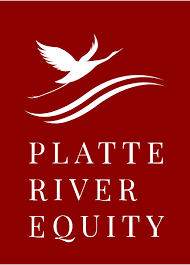
Platte River Equity Portfolio Company Turf Care Supply, LLC Acquires Agri-Nutrients, Inc. Brunswick, OH , October 9, 2024 – Platte River Equity (“Platte River”) portfolio company Turf Care Supply, LLC (“Turf Care”) is pleased to announce its acquisition of Agri-Nutrients, Inc. (“Agri-Nutrients”), a manufacturer and blender of custom granular fertilizers for the turf & ornamental (“T&O”) industry. This strategic acquisition provides Turf Care with an established presence in the south-central United States, an enhanced product portfolio and additional manufacturing capacity. “This acquisition represents much more than a business transaction; it is a strategic step forward in expanding our reach and enhancing our customers’ growth. By bringing Agri-Nutrients into the Turf Care family, we are broadening our product portfolio, expanding our market presence and further positioning ourselves as a leader in providing innovative solutions for our customers,” said Mark Mangan, President of Turf Care. “We are excited about joining the Turf Care team,” said Jim Montgomery, President of Agri-Nutrients. “At Agri-Nutrients, our core values center around customer service and product innovation, and we are confident that this combination will allow us to better serve the needs of our customers.” “Platte River welcomes the Agri-Nutrients team to Turf Care. This transaction underscores our long-term commitment to fostering growth through both organic and inorganic initiatives across the Turf Care platform,” said Tarun Kanthety, Vice President of Platte River. “The partnership with Agri-Nutrients strengthens Turf Care’s value-added offering, creating additional growth opportunities across the combined customer base.” B&A Corporate Advisors served as the exclusive financial advisor to Agri-Nutrients. About Agri-Nutrients Founded in 1992 and based in Catoosa, OK, Agri-Nutrients is a manufacturer and blender of custom granular fertilizers for the T&O industry, predominantly selling into the lawn care, sports turf and golf course end markets. About Turf Care Supply Established in 1974, Turf Care Supply is one of the largest formulators and blenders of urea products to the T&O market. Turf Care has a comprehensive product portfolio of fertilizers, combination products (herbicide/insecticide), soil amendments and enhanced efficiency fertilizer ingredients. Turf Care's products are sold to distributors and blenders serving the commercial, residential and golf end markets. Turf Care operates four manufacturing facilities strategically located throughout the eastern U.S. About Platte River Equity Founded in 2006 and based in Denver, CO, Platte River Equity is a private equity firm focused on investments in established lower middle market operating companies within targeted industrial sectors where it has substantial operating and investing experience. Platte River utilizes prudent capital structures in order to invest in future growth opportunities and withstand changing economic environments. The firm also provides significant ongoing support to its portfolio companies through dedicated resources across functional areas. The firm has raised funds with committed capital in excess of $1.6 billion and is currently investing out of its fifth fund. The Platte River team is the largest collective investor across its funds, deeply aligning the firm with its investors and portfolio company management teams.

